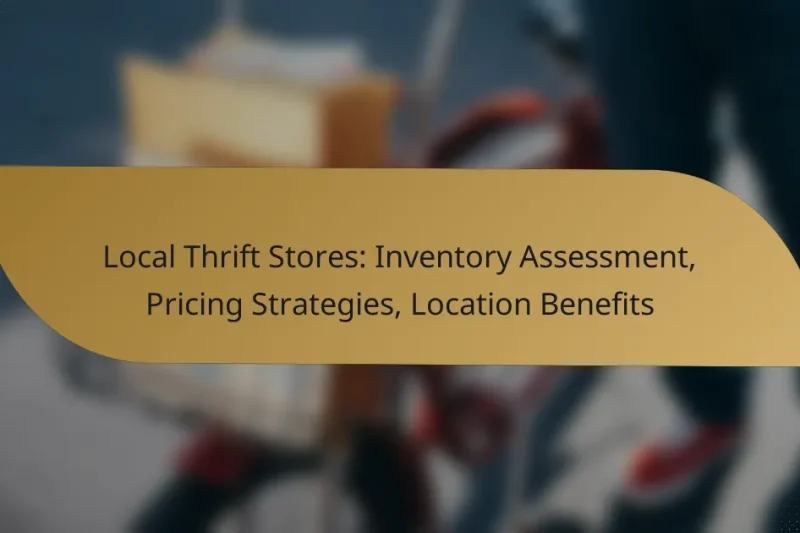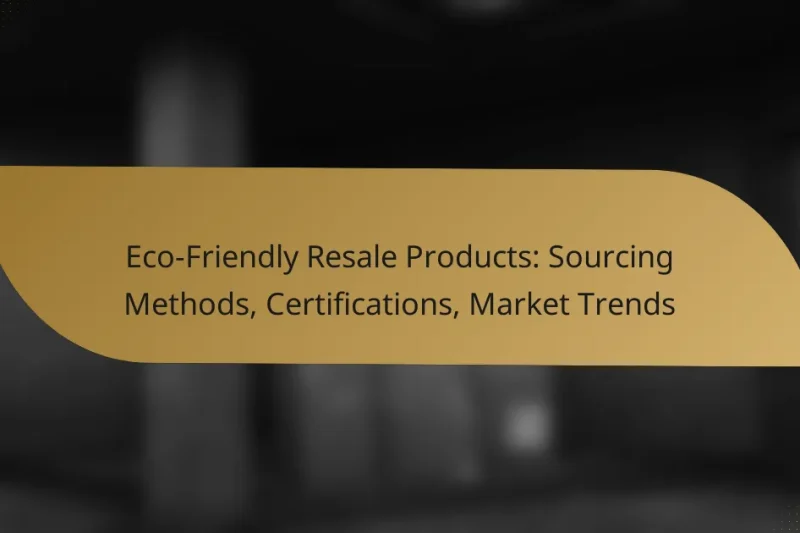Vintage clothing has become a sought-after segment of the fashion market, appealing to those who value … Vintage Clothing: Quality Assessment, Sourcing Locations, Market DemandRead more
Frugal Resale Products: Cost-Effective Sourcing Methods
Frugal resale products offer a fantastic opportunity for entrepreneurs to maximize profits while keeping initial costs low. By employing effective sourcing methods, you can acquire quality items that appeal to buyers, ensuring a successful resale experience. Understanding the best platforms for selling these products further enhances your chances of success in the resale market.
Local Thrift Stores: Inventory Assessment, Pricing Strategies, Location Benefits
Local thrift stores play a vital role in their communities by offering unique items while promoting … Local Thrift Stores: Inventory Assessment, Pricing Strategies, Location BenefitsRead more
Social Media: Platforms, Community Engagement, Local Groups
Social media platforms play a crucial role in fostering community engagement by providing unique features tailored … Social Media: Platforms, Community Engagement, Local GroupsRead more
Online Platforms: E-commerce Sites, Marketplaces, Auctions, Directories
Online platforms such as e-commerce sites, marketplaces, and auction platforms play a crucial role in the … Online Platforms: E-commerce Sites, Marketplaces, Auctions, DirectoriesRead more
High-Demand Items: Price Range, Trends, Categories, Seasonality
In today’s e-commerce landscape, high-demand items encompass a variety of categories such as electronics, fashion, and … High-Demand Items: Price Range, Trends, Categories, SeasonalityRead more
Estate Sales: Unique Finds, Negotiation Strategies, Timing
Estate sales are a treasure trove of unique finds, offering everything from antique furniture to vintage … Estate Sales: Unique Finds, Negotiation Strategies, TimingRead more
Eco-Friendly Resale Products: Sourcing Methods, Certifications, Market Trends
As the demand for sustainable living grows, sourcing eco-friendly resale products has become increasingly important. This … Eco-Friendly Resale Products: Sourcing Methods, Certifications, Market TrendsRead more
What are effective sourcing methods for frugal resale products?
Effective sourcing methods for frugal resale products include various strategies that allow you to acquire items at low costs for resale. These methods can help maximize profit margins while minimizing upfront investment.
Thrift store shopping
Thrift stores offer a treasure trove of second-hand items at significantly reduced prices. When shopping at these stores, look for brand-name clothing, vintage items, and unique home goods that can be resold for a profit.
Visit multiple locations regularly, as inventory changes frequently. Consider shopping during sales or discount days to further reduce costs.
Online marketplaces
Online marketplaces like eBay, Facebook Marketplace, and Craigslist provide access to a vast array of products at competitive prices. You can find both new and used items, often at lower prices than retail.
When sourcing online, be sure to research the seller’s reputation and check for shipping costs. Look for bulk listings or auctions to maximize your savings.
Garage sales
Garage sales can be a goldmine for frugal resellers, offering items at very low prices. These sales often feature household goods, clothing, and collectibles that can be resold at a higher price.
Arrive early to get the best selection and be prepared to negotiate prices. Bring cash and small bills to make transactions easier.
Wholesale liquidation
Wholesale liquidation involves purchasing bulk lots of unsold or returned merchandise from retailers at a fraction of the original cost. This method can yield high-profit margins if you choose the right products.
Research reputable liquidation companies and understand the terms of sale. Inspect the merchandise carefully to ensure quality before purchasing.
Local auctions
Local auctions can provide opportunities to acquire items at competitive prices. Auctions may feature a variety of goods, from antiques to electronics, often sold to the highest bidder.
Attend previews to assess items before bidding and set a budget to avoid overspending. Familiarize yourself with the auction process and any fees involved to ensure a profitable experience.
How to evaluate resale product quality?
Evaluating resale product quality is crucial to ensure you are making cost-effective purchases. Focus on inspecting for damage, checking brand reputation, and assessing market demand to determine if a product is worth reselling.
Inspect for damage
Begin by thoroughly examining the product for any signs of wear or damage. Look for scratches, dents, or functional issues that could affect resale value. A simple visual inspection can often reveal significant problems.
For electronics, check for operational functionality, such as battery life and screen condition. For clothing, inspect seams and fabric integrity. If possible, test the item to confirm it works as intended.
Check brand reputation
Research the brand to understand its reputation in the resale market. Well-known brands often retain value better than lesser-known ones. Check online reviews, ratings, and resale prices to gauge how the brand is perceived.
Consider using platforms like eBay or Poshmark to see how similar items from the brand perform. A strong brand reputation can significantly enhance your ability to sell the product at a desirable price.
Assess market demand
Understanding market demand is vital for successful reselling. Use online tools and marketplaces to analyze trends and see how quickly similar items sell. Look for seasonal demand fluctuations that could impact pricing.
Check social media and forums to gauge consumer interest. If a product is trending or has a loyal following, it may be worth investing in, even if the initial cost is higher. Aim for items that have a consistent demand to ensure quicker sales.
What are the best platforms for reselling products?
The best platforms for reselling products include eBay, Poshmark, Facebook Marketplace, and Depop. Each platform has unique features and target audiences, making them suitable for different types of products and sellers.
eBay
eBay is one of the largest online marketplaces, allowing users to auction or sell items at fixed prices. Sellers can reach a global audience, making it ideal for unique or collectible items. Consider the fees, which typically range from 10% to 15% of the sale price, and factor this into your pricing strategy.
To maximize sales, ensure your listings have clear images and detailed descriptions. Research similar items to set competitive prices and consider using eBay’s promotional tools to increase visibility.
Poshmark
Poshmark specializes in fashion and accessories, making it a great choice for sellers with clothing items. The platform encourages social interaction, so engaging with potential buyers can boost your sales. Poshmark takes a flat commission of $2.95 for sales under $15 and 20% for items priced above that.
To succeed on Poshmark, create appealing listings with high-quality photos and use relevant hashtags. Participate in Posh Parties to increase your exposure and connect with other users.
Facebook Marketplace
Facebook Marketplace allows users to sell items locally or ship them nationwide. It is user-friendly and integrates with your existing Facebook account, making it easy to list items. There are no selling fees for local sales, which can enhance your profit margins.
When using Facebook Marketplace, be clear about your item’s condition and pricing. Respond promptly to inquiries and consider meeting in safe, public locations for local transactions.
Depop
Depop is a mobile app focused on fashion, particularly vintage and streetwear. It attracts a younger demographic, making it ideal for trendy clothing and accessories. Depop charges a 10% fee on sales, which is lower than some other platforms.
To stand out on Depop, use creative photography and engaging descriptions. Engage with the community by following other users and sharing their listings, as this can lead to reciprocal support and increased visibility for your items.
What are the costs associated with sourcing resale products?
Sourcing resale products involves various costs that can impact overall profitability. Key expenses include the initial purchase price, shipping fees, and storage costs, each of which requires careful consideration to maintain a frugal approach.
Initial purchase price
The initial purchase price is the most significant cost when sourcing resale products. This price can vary widely based on factors such as product type, brand, and condition. For instance, buying in bulk often reduces the per-unit cost, making it a more economical choice for resellers.
When evaluating potential products, consider setting a budget that allows for flexibility. Aim for products that can be sourced at a discount, whether through clearance sales, liquidation auctions, or wholesale suppliers. This strategy can help maximize profit margins.
Shipping fees
Shipping fees can add substantial costs to sourcing resale products, especially when purchasing from distant suppliers. It’s essential to factor in these expenses when calculating the total cost of goods sold. Consider using shipping calculators to estimate costs before making a purchase.
To minimize shipping fees, explore options like bulk shipping or negotiating rates with carriers. Additionally, consider sourcing products locally to reduce transportation costs and expedite delivery times.
Storage costs
Storage costs arise from the need to keep inventory until it is sold. These costs can include renting warehouse space or utilizing self-storage units, which can vary significantly based on location and size. It’s crucial to assess how much inventory you can realistically store without incurring excessive expenses.
To manage storage costs effectively, implement an inventory management system that tracks product turnover. This helps ensure that you are not holding onto excess stock for too long, which can lead to increased storage fees and reduced profitability.






